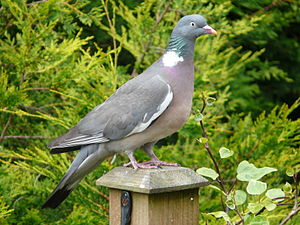Woodpigeon
| Common wood pigeon | |
|---|---|
 |
|
| Perching on a garden fence post in England |
|
| Scientific classification | |
| Kingdom: | Animalia |
| Phylum: | Chordata |
| Class: | Aves |
| Order: | Columbiformes |
| Family: | Columbidae |
| Genus: | Columba |
| Species: | C. palumbus |
| Binomial name | |
|
Columba palumbus Linnaeus, 1758 |
|
 |
|
| Global range Year-Round Range Summer Range Winter Range | |
The common wood pigeon (Columba palumbus) is a large species in the dove and pigeon family. It belongs to the Columba genus and, like all pigeons and doves, belongs to the family Columbidae. It is locally known in southeast England as the "culver"; This name has given rise to several areas known for keeping pigeons to be named after it, such as Culver Down.
The genus name Columba is the Latin word meaning "pigeon, dove", whose older etymology comes from the Ancient Greek κόλυμβος (kolumbos), "a diver", from κολυμβάω (kolumbao), "dive, plunge headlong, swim".Aristophanes (Birds, 304) and others use the word κολυμβίς (kolumbis), "diver", for the name of the bird, because of its swimming motion in the air. The specific epithet palumbus is derived from the Latin palumbes, "wood pigeon".
In the colder northern and eastern parts of its Europe and western Asia range the common wood pigeon is a migrant, but in southern and western Europe it is a well distributed and often abundant resident.
The three Western European Columba pigeons, common wood pigeon, , and rock pigeon, though superficially alike, have very distinctive characteristics; the common wood pigeon may be identified at once by its larger size at 38–44.5 cm (15.0–17.5 in) and 300–615 g (10.6–21.7 oz), and the white on its neck and wing. It is otherwise a basically grey bird, with a pinkish breast. The wingspan can range from 68 to 80 cm (27 to 31 in) and the wing chord measures 24 to 25.4 cm (9.4 to 10.0 in). The tail measures 13.8 to 15 cm (5.4 to 5.9 in), the bill is 1.9 to 2.2 cm (0.75 to 0.87 in) and the tarsus is 2.5 to 2.8 cm (0.98 to 1.10 in). Adult birds bear a series of green and white patches on their necks, and a pink patch on their chest.
Juvenile birds do not have the white patches on either side of the neck. When they are about six months old (about three months out of the nest) they gain small white patches on both sides of the neck, which gradually enlarge until they are fully formed when the bird is about 6–8 months old (approx. ages only). Juvenile birds also have a greyer beak and an overall lighter grey appearance than adult birds.
...
Wikipedia

